If you’re anything like me, just hearing the words “bass fishing” evokes childhood memories of sweltering hot summers and brightly colored deer hair poppers. I can vividly remember riding my bike, fly rod clutched tightly across the handlebars, to Tony Specchio’s farm. My excitement grew with each carefully placed step as I traipsed across the “fragrant”cow pastures to fish my favorite pond. Like most “noobie” fly anglers, I cut my teeth catching largemouth bass.
“Count to one hundred, ” Dad used to say, “that’s how long you should wait before moving your popper.” As a youngster, it always felt like an eternity watching the concentric waves expand away from the fly as they disappeared into the glassy surface of the pond. After about thirty seconds, I just couldn’t take waiting anymore. I would bring my popper to life, awakening the pond with a loud Baaa-LOOUpe! A siren call to ready and waiting bass lurking in the cattails. To this day, I just don’t know what’s better, the violent explosion when the bass decides to eat, or the anticipation building up to the ambush. I guess it’s all part of the experience and what draws us all back to largemouth bass.
I forgot just how much fun it was until it was time to teach my little girl how to fly fish. Unlike other freshwater species whose diet consists of minuscule bugs and worms, a largemouth can, and will, eat just about anything that hits the water. Although small baitfish, frogs, and lizards immediately come to mind, they will also consume small mammals, birds, and even baby alligators (here in FL)!
That being said, here is my assortment of proven classic and contemporary patterns that provided a wide array of menu options for a fantastic day on the water.
If you would like detailed, illustrated, step-by-step instructions on how to tie all these 7 bass flies, head pick up a copy of my Largemouth Bass Flies book or eBook.
King Rat
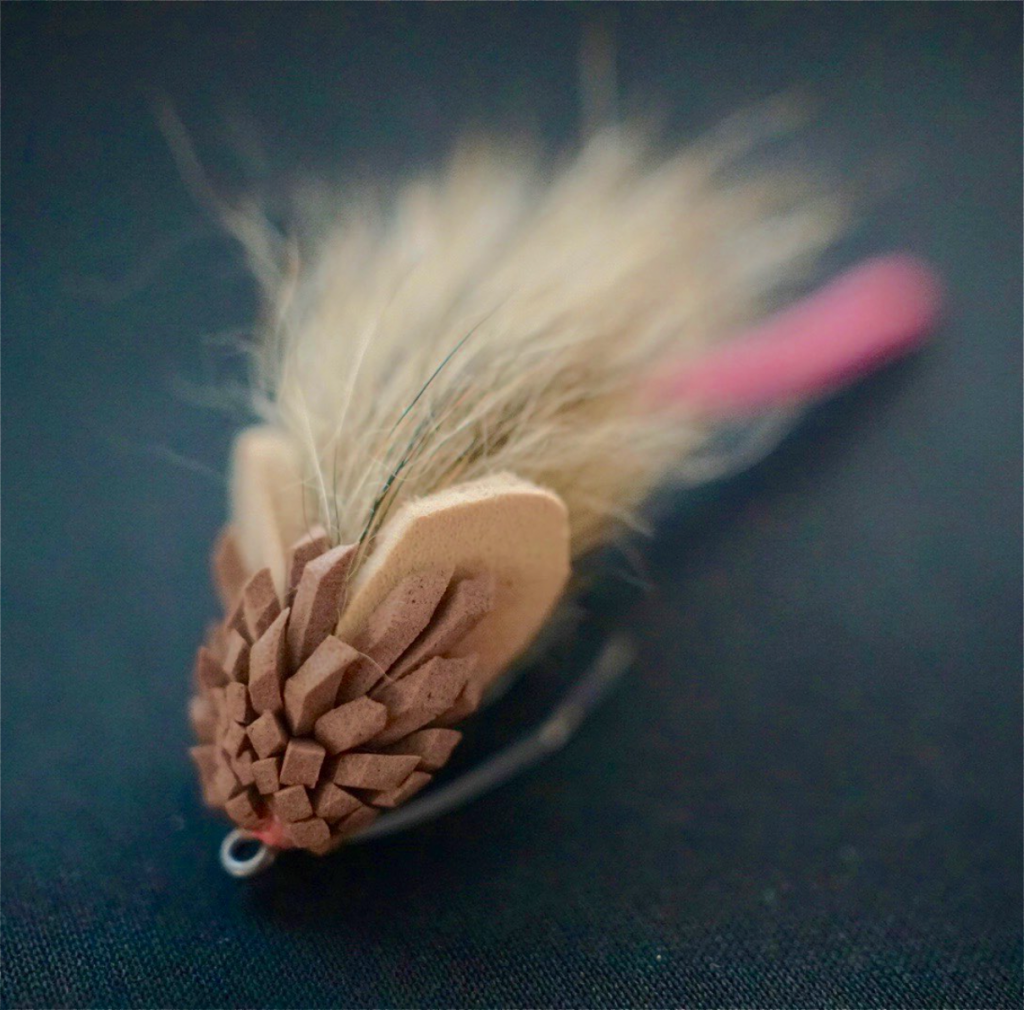
One of my favorite parts of any destination trip is the months of preparation. I enjoy researching what flies have been historically productive in a given estuary and spend a considerable amount of time scouring the Internet for new patterns and relish comparing notes with fellow fly tying fanatics and anglers. King Rat was the product of a hot tip that mice patterns had been working in the Ibera Marsh. I was headed to Argentina for Dorado, so I began experimenting with a few classic spun deer hair patterns that I used for largemouth bass in the past. I have to admit, it had been a while since I broke out the old hair stacker, but I was pleased with how the first few flies turned out … on the bench anyway. Multiple bundles of consecutively shorter stacks of deer hair were used to shape the rodent’s body and a shaved rabbit zonker strip tail gave the fly some needed movement in the water. Large leather ears adorned each side of the head and completed its charmingly realistic look. Unfortunately within moments, the fly soaked up water like a sponge and it became heavily saturated and cumbersome to cast. Once waterlogged, my useless shadow-box mouse sunk quickly, which would be an issue with the thick, submerged vegetation and any notion of long-range accuracy became laughable.
The fishing conditions in the Ibera Marsh are somewhat technical and a little tricky; often calling for a long back cast over tall grass, so a fly that casts like a wet rag wasn’t going to get it done. Not to mention that several species in the estuary have razor-sharp teeth, so the durability of the rabbit strip tail and deer hair became a non sequitur. It was also crucial that the fly was weedless since the vast majority of the fishable water was overrun with vegetation … much like the environments I fish here in the states for largemouth bass.
My search for a comprehensive mouse pattern that would fit the bill for this fishing scenario was coming up short, but my research wasn’t completely fruitless … I did manage to learn quite a bit about rats. Turns out the super-sized rodents inhabit most of the world, are excellent swimmers, and can hold their breath for up to 3 minutes! This got me thinking and my quest to design a first-rate rodent began.
The hook and platform for this royal rat needed to be large enough to accommodate a long fluffy body while at the same time providing a wide gap and exhibit formidable strength. I tested several long shank hooks for the job and after successfully pounding a 2/0 Mustad into a dock pile and leaning on it with my 10 weight without failure, I knew I had the winner. Kevlar (the same material used in bulletproof vests) thread was purposefully chosen to lash the materials to the hook and provide the fly with an added layer of durability. Nothing is impervious to piranha attacks indefinitely, but this would certainly help! The body material needed to be soft enough to lay backward and not flare when spun in a dubbing loop, and it needed to be long enough so it could be consecutively tapered without cutting off the tips of the fur to give the fly a realistic shape. Whenever possible I opt for natural materials and the coyote fur’s texture, length, and coloration were exactly what I was looking for. The fur quickly sheds water after a false cast or two allowing for the fly to exhibit an extremely large profile in the water, yet it remained light and aerodynamic to cast after hours of fishing.
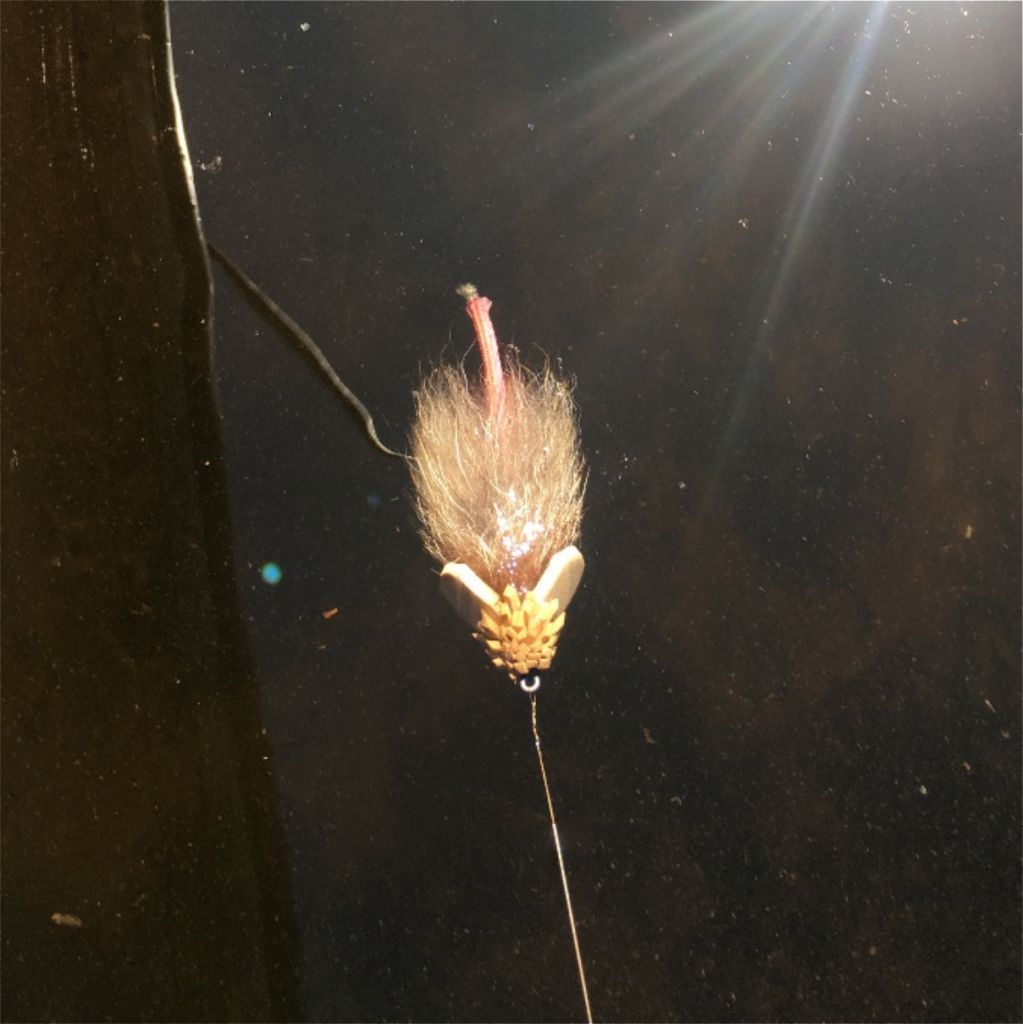
The position of the fly in the water column and how it should move when stripped was also very important to its effectiveness. I managed to find some videos online of rats swimming and I was amazed on how fast and efficiently they moved through the water using their tail as a rudder while doggie paddling with their front legs. Their face remained out of the water for the most part, so the head of the rat fly needed to ride higher and be considerably more buoyant than the body of the fly. When motionless, a rat’s thin, soft hair ungulates with the current, making them look like a much larger meal to a game fish than they really are. In order to achieve the desired result, I traded in the usual leather or felt ears for 3mm foam and added to the buoyancy by fashioning the rat’s head with tightly packed spun foam strips. To beef up the flies durability and realistic look in the water, I substituted the supple rabbit zonker strip for a ridged para-cord tail.
The para-cord could take much more abuse from the piranhas that would frequently attack the fly, and the inherent stiffness of the material also kept it from wrapping around the hook and fouling. I chose the pink color since it was somewhat natural looking, but mostly because it was easy to see in the water at great distances. This was key for tracking the fly and insuring that you didn’t miss the strike. After days of torture testing and tweaking the pattern, getting fish to eat it was no longer the issue … it was keeping them hooked during the acrobatics that followed.
After nearly a half dozen dorado came unbuttoned, I put the microscope on the most crucial element of this pattern … the weed guard. The classic bass bug weed guard (double loop of mono running down the bend of the hook and back to the eye) looked great, but proved to be counterproductive when put into action. Once I made the adjustment to a double post 30lb Mason hard mono it was on! We torture tested the pattern for 2 more days, dragging it overtop the islands of grass and lily pads throughout the marsh. The ferocious strike typically happened when the fly hopped off the vegetation into the water with an audible plop.
The name “King Rat” came from Pira guide, Francois Botha, while field testing the pattern. I thought its double meaning was perfect for this fly. I have heard the term used to describe an abnormally oversized rat, but “King Rat” is also a handle commonly used by South African fishermen for the biggest fish of its kind. The saying goes that “King Rat” is so big that the cats run away when they see him. No minuscule mouse pattern was going to suffice when targeting the largest specimens of this barbaric species … if we wanted to catch “King Rat” we were going to need a monster mouse!
Although this pattern was originally designed for dorado, it has proven itself on bass as well as many other species. I have to say I’m always surprised what eats these things!
Leiser’s Bass Angus
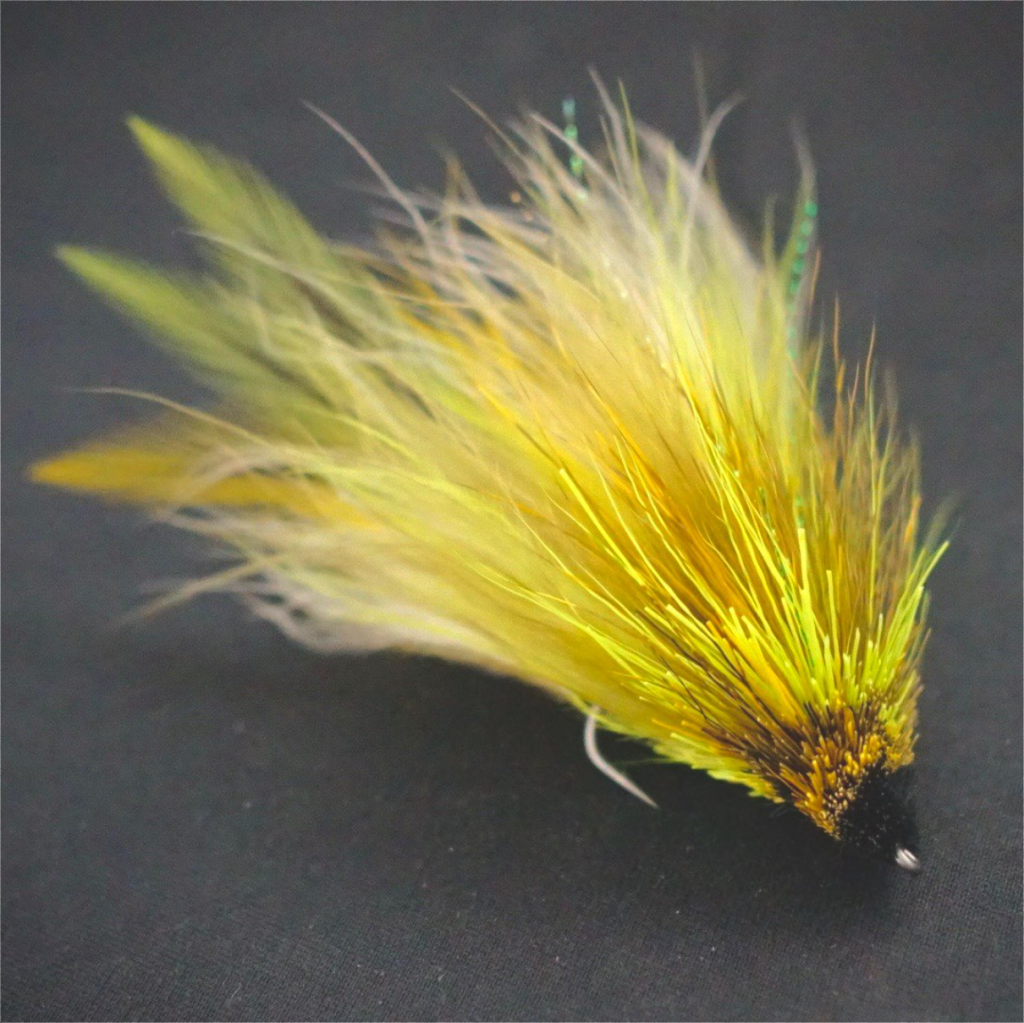
After receiving the news that my latest 3 books had gone off to print, I couldn’t help but take a minute to reflect on how this fly tying thing all got started. Over the past three decades, I have learned a lot about tying flies from books, videos, and the Internet, but the lessons that I hold closest to my heart I learned while sharing the bench with friends. My journey as a tyer and teacher has been blessed with numerous fantastic mentors that have not only sharpened my skills at the vise, but also helped me become a better instructor. Nothing I have accomplished would have been possible without the selfless generosity of countless fly-fishing friends and supporters. For the most part, each of my mentors specialized in a specific style of tying and excelled at a handful of patterns for a specific species or fishing scenario. Very few individuals I have met along the way have had the ability to tie the entire spectrum of flies without difficulty. My good friend, Eric Leiser, is most certainly the exception. No one I have ever met has more knowledge of everything fly tying. His lessons, guidance, and encouragement have inspired me to write and teach every day.

I first met Eric back in 2008 thanks to my good buddy Joe Mahler. Eric lived just over the bridge in Cape Coral and Joe arranged a lunch meeting for us two at Jason’s Deli. We quickly be came friends and began getting together to tie flies. I had just begun working on Feather Brain at the time and as an accomplished author in the industry, Eric was pivotal in helping form my own writing and teaching styles. When he first took me under his wing, Eric graciously shared his vast knowledge of materials, tips, tricks, and techniques with me, but there was a catch … he made me promise that I would always share my knowledge with others. No secrets. So that’s why I do what I do. This pattern is a special one for me since I learned it firsthand from the man himself.
Pineapple Grenade Popper
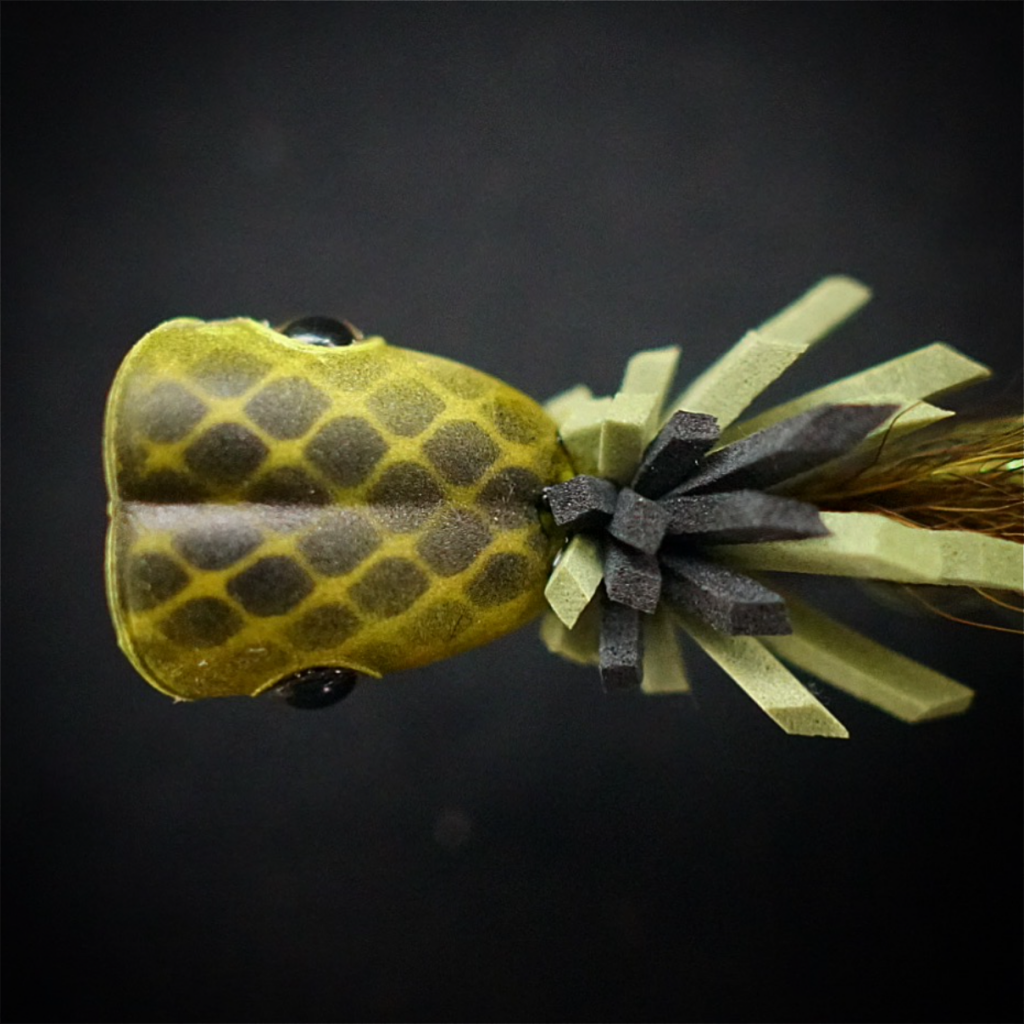
One of my favorite activities to do with my daughter is making foam poppers. We break out the foam cylinders and airbrush, and typically paint up a couple dozen at a time. It’s a fun and easy fly for kids to start with. It’s fun for Dad, too! When it comes to choosing the body material, you can go wood if you have the patience, but I normally opt for the foam because there’s not a lot of prep work and hassle involved. Like most five-year-olds, Lucy’s attention span is pretty short, and if it’s not exciting right away, she is on to the next game or project. The foam bodies allow you to get right down to business.
Until recently, my first choice was cutting the foam cylinders to shape using Gary Krebs’ Popper Jig. These work great, but you do have to break out a razor blade to shape the foam and there is a little guess work in affixing the foam to the hook. The other store-bought option that I have played around with in the past , is the Hard Foam Popper Bodies. These look great, hold paint well, and glue up nicely. But they aren’t very durable. One miscalculated cast against a rock or a ricochet off the engine and you’re left with a hook and a tuft of deer hair—needless to say, they are not my favorite.
I had the pleasure of talking to the guys at the Flymen Fishing Company at iCast last year, and they sent me home with some new popper bodies to experiment with. At first glance, new Surface Seducer® Double BarrelTM popper and slider bodies looked cool, but looks can be deceiving when it comes to surface flies.
The biggest issues are sinking short strikes and surface sliding. Most poppers are notorious for sliding or getting pushed out of the strike zone at the last second due to their design. If there is not enough resistance at the front of the fly it will not push water and give you the desired “gluuug” or “pop” sound. Skating around on the surface also leads to short strikes or poor hookups. A longer hook shank will most definitely assist with this, but that’s really more of a bandaid fix. Throwing a couple of sequins in front of the foam lip or head like the Disco Shrimp is another remedy. It’s easier to go with a better body.
I did run into a bit of an issue when my friend Oliver White asked me to whip him up some 6/0 poppers for Oman. The problem being that, and 6/0 hook is too heavy for even an XL Double Barrel Popper to keep afloat. After several days of experimentation, I came up with the fix! The spun fettuccine foam collar at the rear of the fly was just what the bug needed to regain its buoyancy. A couple of happy accidents that I hadn’t anticipated were the extra surface drag the multiple strips of foam created. This really helped the fly from sliding and also produce a coveted bubble trail, which all fish love, including bass … and, you don’t need a 6/0 hook to land them!
Mahler’s StrawBoss
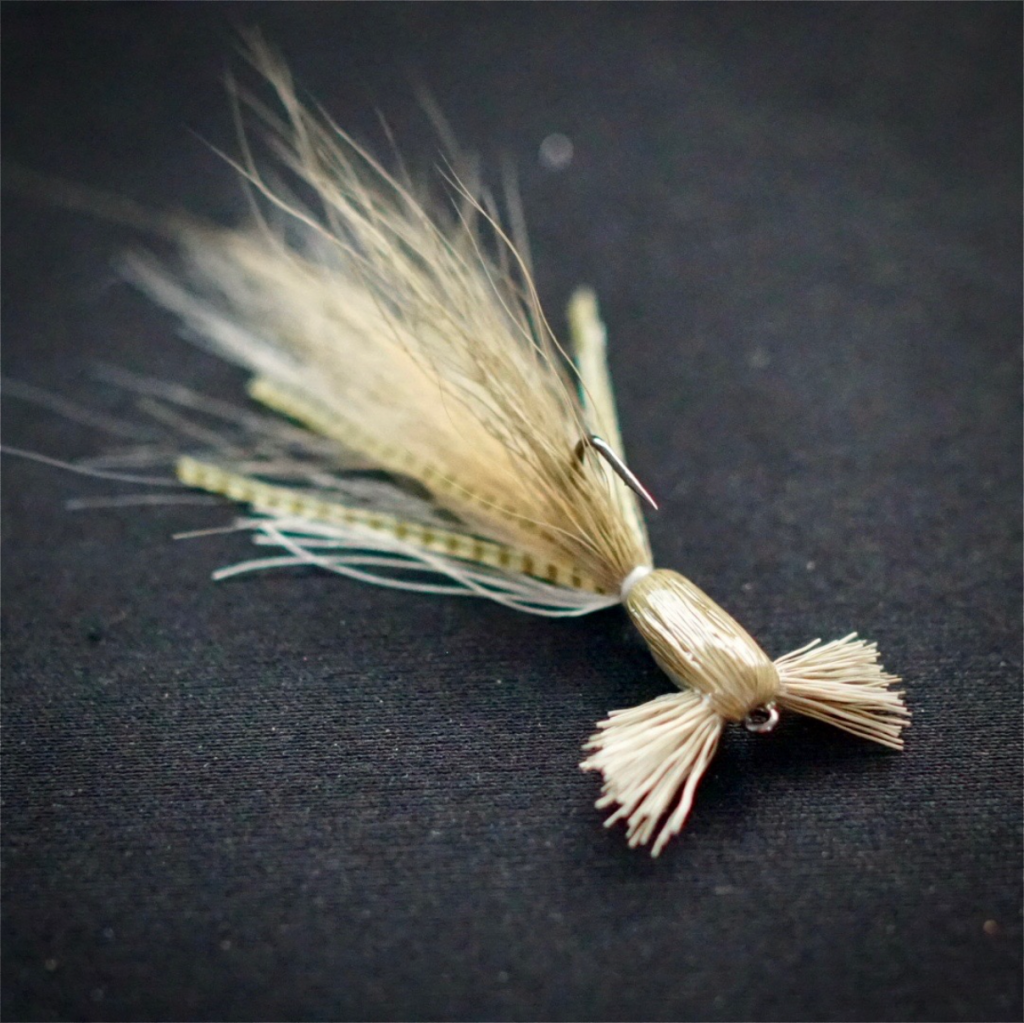
Having spent the better part of the last decade developing, tying, testing, and improving flies, I have learned a thing or two about what triggers fish to strike. Reading fish and learning the subtle nuances of a particular specie’s feeding behavior takes patience and persistence to say the least … and even after years of on the water experience, these behaviors can never be fully understood or easily predicted.
Whether you’re fishing in fresh or saltwater, probably the most overlooked attributes of any fly is its sink rate. In order for your fly to mimic the intended prey item, it needs to sink at the same speed to look natural. A fly that plummets too fast through the water column is often a red flag to skeptical fish and an indignant refusal usually follows. This is especially crucial for warm-water species like largemouth bass.
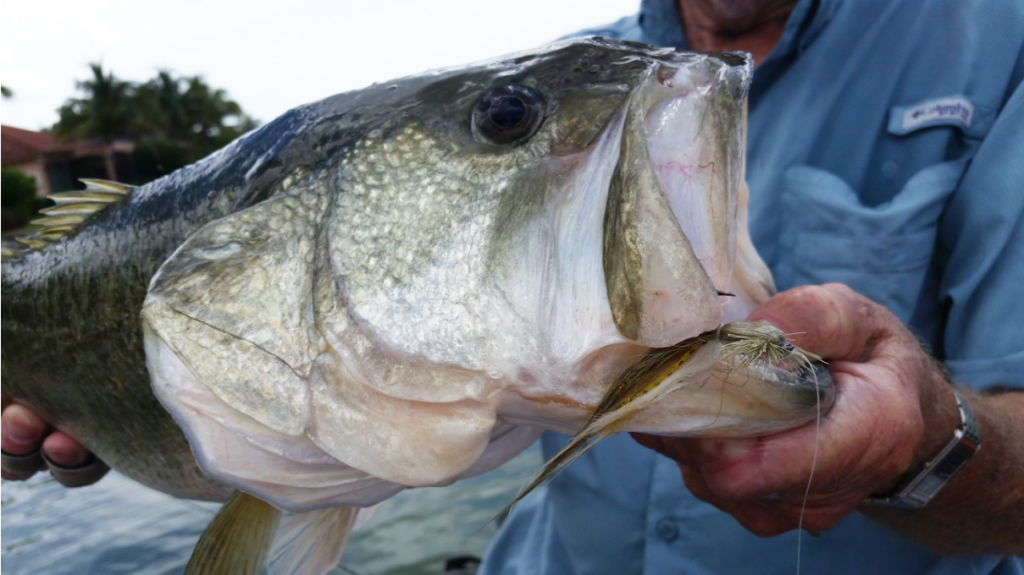
Anglers of any sort are familiar with the axiom “fish hit it on the fall,” and while spin- fishermen—particularly bass fishermen—live by the rule, fly-rodders often focus on other traits of the fly’s physical appearance, profile, or swim action. Hook size, added weight, leader material, or any number of other factors can affect how your fly falls through the water. Sometimes a minor adjustment in the sink rate of a fly is all you need to make your fly appear more natural and turn on the bite. Testing your patterns in a pool or tank is a good way to analyze how they will perform before making adjustments to their weight or buoyancy. The important thing is for the fly to look natural as it falls to the bottom.

You know you have cracked the code when you start getting strikes on the drop. Oftentimes, a pattern with a slightly longer pause, or prolonged decent, will out fish other patterns because it’s simply in the strike zone longer. A shining example of this coveted characteristic is Joe Mahler’s StrawBoss pattern, which takes the ever- important falling motion to a new level.
At first glance, the StrawBoss has all the telling features of a classic top-water bass bug. One would think the bulbous head and broad buck tail wing to be a forgone conclusion for bulldozing water and making a frothy disturbance on the surface … but this notion couldn’t be further from the truth. Beneath the burnished shell of buck tail, is a thoughtful balance of floating and sinking materials that Mahler refers to as “buoyancy management.” Borrowing scud weights from the trout fishing world, and a little first aid finger tape from the pharmacy, the StrawBoss maximizes time in the strike zone by casually listing back and forth on its way to the depths. Mahler views the StrawBoss as more of a tying platform than a pattern, adjusting the sink rate, accouterments, and appearance for the circumstances and species. Adding mono eyes, rubber legs, or flash, when appropriate, will give the StrawBoss versatility far beyond the bass pond. Joe’s original pattern was tied with the hook point down, but in recent years, he ties nearly all of his flies hook point up, making the fly nearly snag free and achieving what he believes are more solid hook ups.
Mahler’s recommendations for fishing the StrawBoss:
When fishing drop offs of any kind, strip the fly to the edge and let it fall. Try waiting for a ten-count, or even more, while keeping the line tight and watching for a strike. Frequently, on the first strip, you will feel the resistance of the bass.
“The StrawBoss is best fished at a very casual pace,” Joe says. “While many strikes occur on the fall, the fly also has a distinctive motion when stripped. Because the weight is distributed laterally and concentrated in the center of the shank, the StrawBoss tends to gently “toggle,” giving it a life-like swimming motion. “Inching” the fly along using quick micro-strips (using only the thumb and index finger) is a great way to entice the larger, more educated fish.”
“When fishing sandy or mud bottoms, I let the fly settle to the bottom before making a quick strip to kick up dust,” says Mahler, “the combination of the weighted belly and the outstretched wings, will make quite a cloud.”
If you are looking for a quick tie … this wouldn’t be the fly I would recommend. Tying Mahler’s StrawBoss is not for the impatient. It requires a significant time commitment for even the most experience tyer. Take your time and a little extra care, and you may just find the new boss of your bass box.
Sunny Corleone
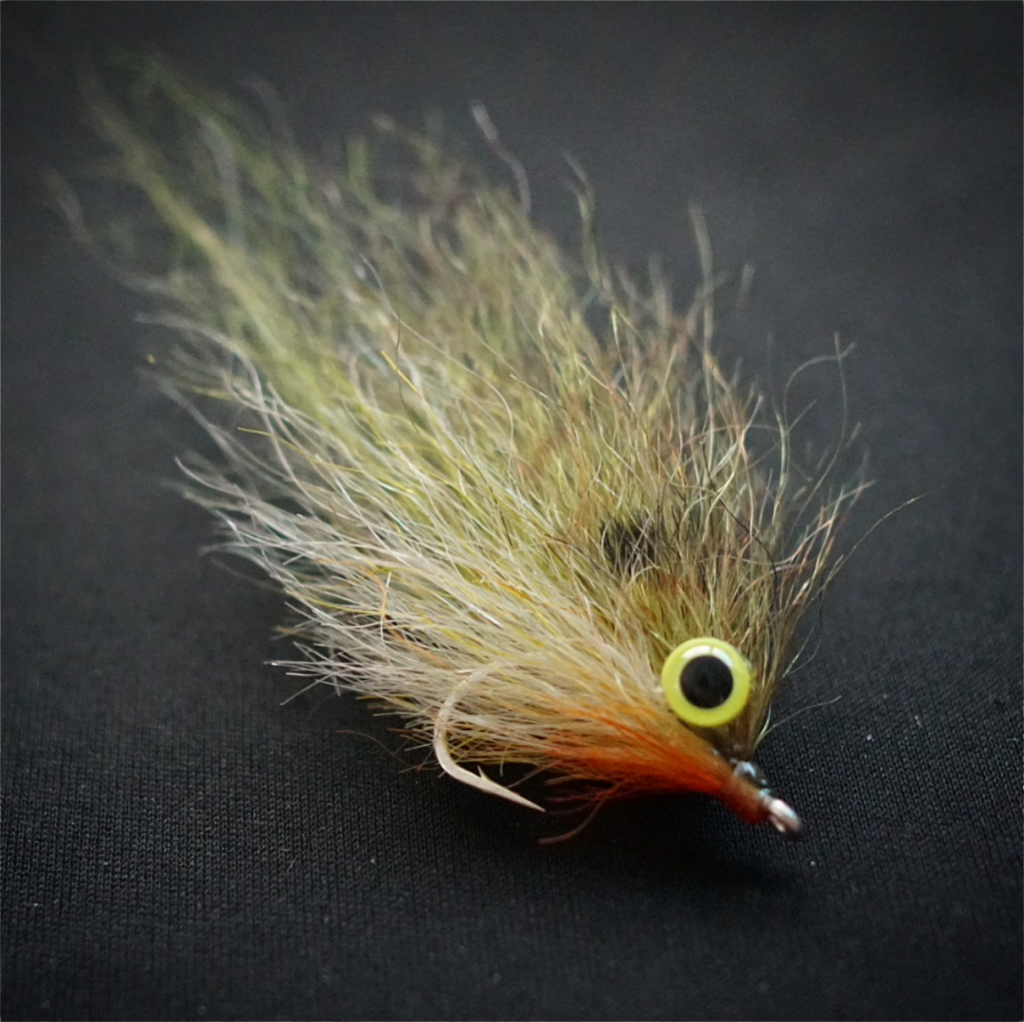
This vibrant imitation emulates any number of 3 – 5″ adolescent sunfish, bluegills, and brim that congregate around grass lines, docks, or structure. Native to North America, these fish can be found in streams, rivers, lakes, and ponds. They are highly adaptable and can thrive in just about any environment. Because they are so prevalent, they often fall prey to many larger game fish species. Although bass is the primary target for this pattern, you may occasionally pick off other species such as trout, muskies, and pike with this little guy. The pattern’s bright colors of saltwater yak hair blend for a more realistic look. It’s one of my favorite attractor patterns and it really gets the attention of even the most uninterested fish.
If you hadn’t figured it out, my heritage is Italian … and therefor you’re pretty much predisposed to Sunday dinner and mob movies. This gangster baitfish’s name pays homage one of my favorites, Mario Puzo’s Godfather. Unlike his soft-spoken, quietly calculating father, Sonny is flashy, hot-tempered and quick to start a fight. I thought it was only fitting for a fly that openly antagonizes the bigger fish in the pond and gets violently whacked!
It is tied in a similar fashion as many of my other baitfish patterns to create a wide profile. The pattern uses saltwater yak hair mostly for its translucent qualities— but also because its length and wiry texture allows you to create larger and more durable flies. The natural yak hair is great for blending because you can easily count the strands of hair. This allows your flies to be more uniform in color and fullness. The coarse hair becomes supple when wet and has a lifelike quality when stripped.
CJ’s Freaky Frog
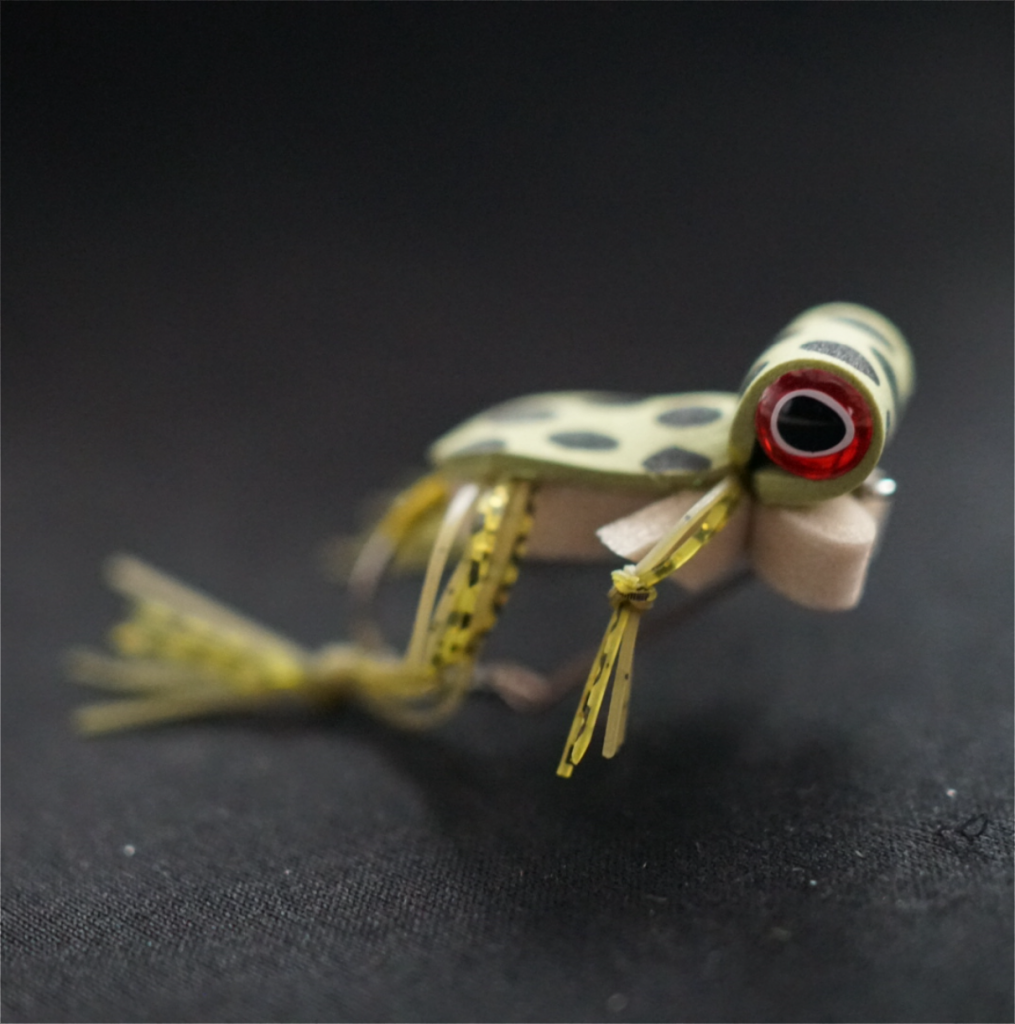
Chad “Mississippi” Johnson is a native of Crystal Springs, MS. His love for fly fishing began after he first visited the area in the spring of 2003. Chad and his wife, Tiffany, moved into the White River area in July 2006. He has guided on the White River system since 2007. He has also guided out of Rocky River Lodge in Port Graham, Alaska in 2007 & 2010, for both salmon and dollie varden seasons.
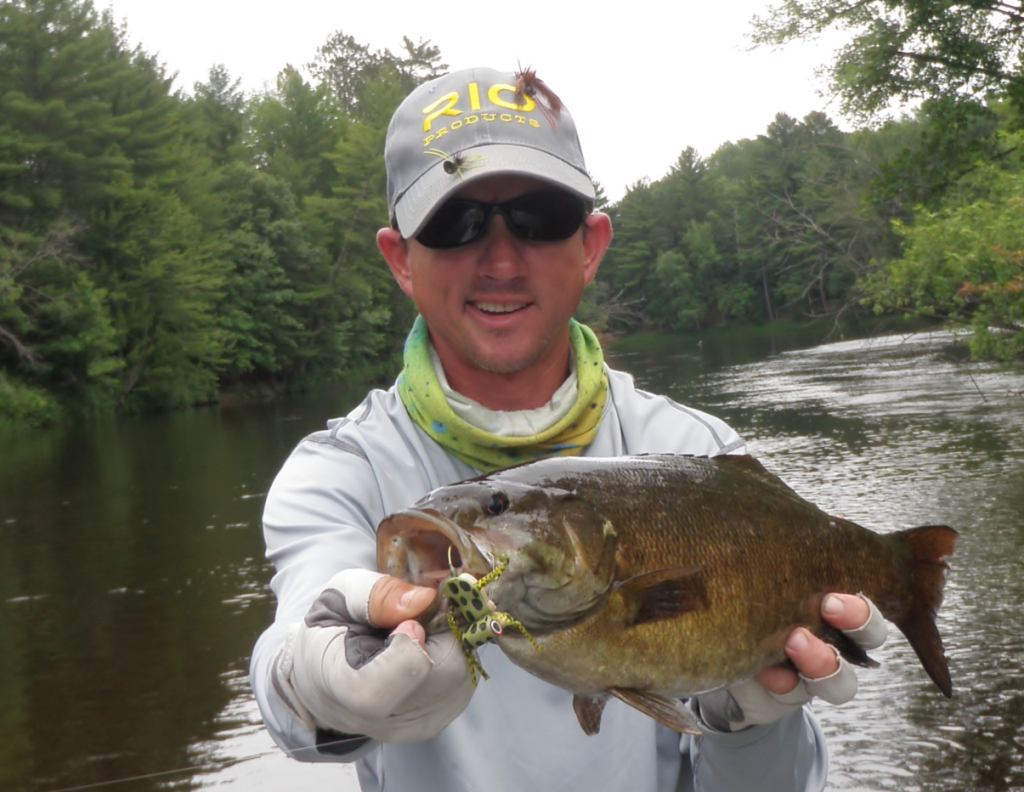
With persistence and hard work, Chad has accomplished more than he could ever imagine. He has been featured in several magazine publications such as Gray’s Sporting Journal, Eastern Fly Fishing, American Angler, Fly Fisherman, and Outdoor Life. He has also been featured in book such as “Nymph Masters: Fly Fishing Secrets from Expert Anglers” and “Feeding Time: A Fly Fisher’s Guide to What, Where & When Trout Eat” both by Jason Randall and “Strip-Set: Fly- Fishing Techniques, Tactics & Patterns for Streamers” by George Daniels. He is currently working with Landon Mayer on his upcoming book.
He is a Simms Guide Pro, RIO Pro, Costa Del Mar Pro, Shawnee/Supreme/Predator Pro Staffer.
As the head guide for Dally’s Ozark Fly Fisher, Chad guides more than 200 days a year and is widely acknowledged as one of the best streamer guides in the country by high-profile streamer gurus like Blane Chocklett and Kelly Galloup.
He is an innovative and award-winning fly tyer who is sought after for his outstanding fly tying demonstrations.
Chad’s laid-back Mississippi accent and style make him a crowd favorite everywhere he goes.
“Bottom line is there’s no better place to be than in the boat with a customer sharing this sport. I love my job! I had no idea that my move from Mississippi would land me on such a fast track to such an awesome fly fishing career. Thanks to all of the support of the fly heads out there.” – Chad Johnson
Carnivore Crayfish
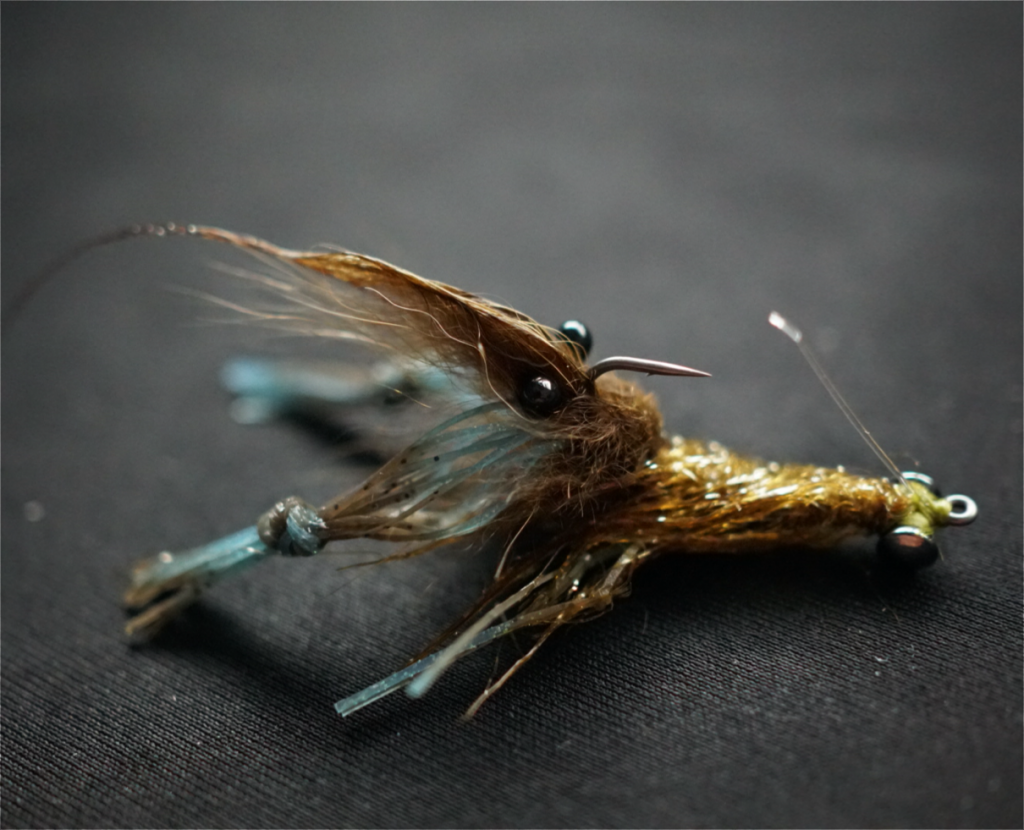
The trick to catching crayfish is to lift one end of the rock very slowly so you don’t disturb the bottom too much. Large flat rocks always seemed to be the most fruitful for me as a kid … if I could muster the strength to pry them loose from the muddy creek bottom. By the time I was old enough to fish by myself, I was an expert at capturing the minuscule crustaceans. With grandma’s mop bucket in tow, I would pounce on the primo bass bait quickly with a three finger Kung Fu grip before they had time to dart out of hiding, backwards, and vanish. If you distracted them with one hand the more aggressive ones would choose fight, rather than flight and put their claws up in a defensive posture … and although they were only a few inches long, if one of these little savages got a hold of you, you knew it!
Once I had a half dozen or so, I would march out to the end of the dock in my soggy Chuck Taylors, tail hook one of my query and launch it toward the weed bed. I was always amazed how fast they rocketed towards the bottom, and quickly found a new rock to hide under.
The process of designing a fly can take weeks, months and sometime years to get right. Selecting the right hook, materials, and essential components to impart the fly with the desired presentation and action typically takes quite of bit of trial and error, and usually one of the pieces to the puzzle isn’t quite right at first. That being said … conjuring up a crayfish pattern seemed to be second nature for me after analyzing their characteristics, colors, and behaviors for the better part of my childhood.
Like any other bottom-dwelling critter, their coloration is unique to the estuary they reside. The vast majority of the ones, in my neck of the woods, were a muddy brown with highlights of brick red or baby blue on the legs, tail, and claws. If you divide this mini lobster into two pieces, you are left with a head and appendages and a large segmented tail. The cone-shaped head is accomplished with the long translucent guard hairs of the Finnish raccoon fur. When held up to the light, the tail portion is compressed of five pairs of swimmerets which give it a semi-translucent look. Oversized forward facing claws are the main defense mechanism of this little guy and are a key attribute to emulating them effectively.
The 7/32″ brass Dazl-Eyes looks like overkill at first glance, but I find that this much weight is necessary to get the fly down to the bottom, quickly and offset the buoyancy of the rubber claws when tied in this size. Once on the bottom it is held stationary while the claws float upward in the fighting portion.
4-6” micro strips will hop the fly rearwards, then it will quickly settle to the bottom again, giving the fly a very natural flight and fight posture in the water.
A single weed guard is usually enough to keep this pattern snag-free, but it can easily be replaced with a double post weed guard for heavy structure or grass.
Learn How to Tie These 7 Effective Bass Flies
For step-by-step instructions on how to tie all these 7 bass flies, head pick up a copy of my Largemouth Bass Flies book or eBook.
